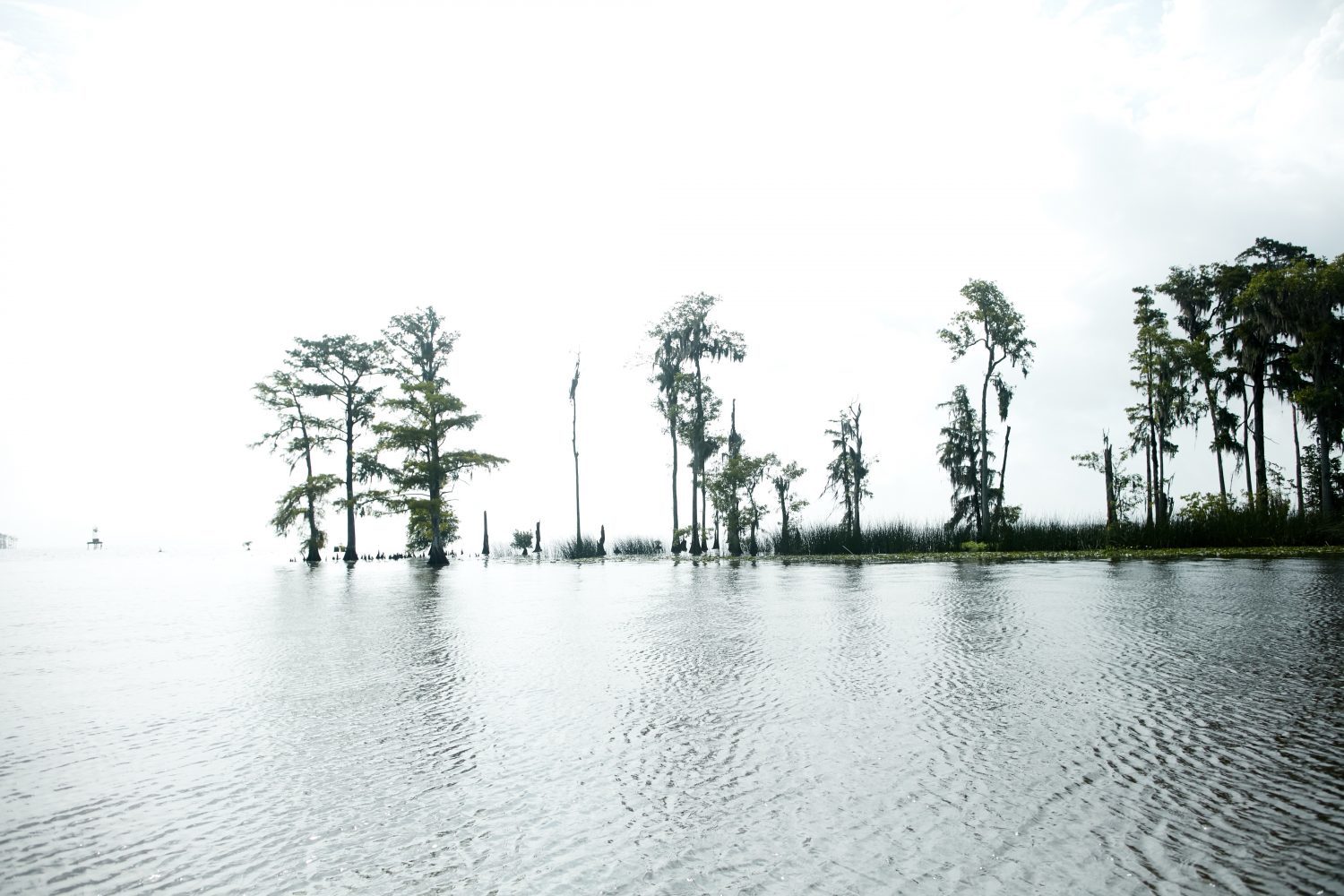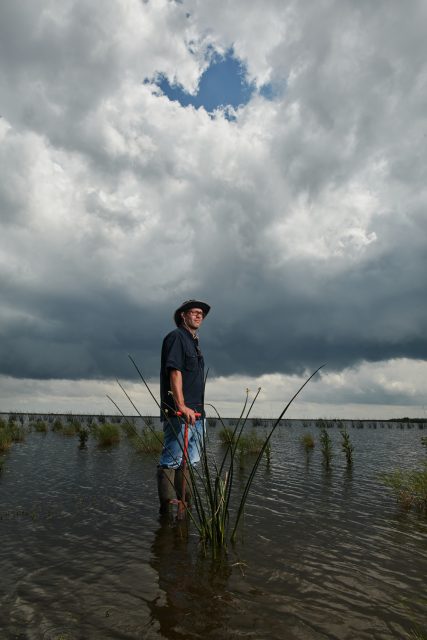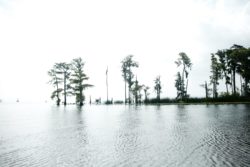Coastal
The Marsh Doctor
LDAF’s Blaise Pezold and an army of volunteers replant Louisiana’s fragile wetlands.
Published: September 7, 2017
Last Updated: October 14, 2021

Ben Depp
Bulrush grass planted last year thrives on the edge of Lake Maurepas.
The aim of these plants was to create a vegetative barrier that would prevent waves from continuing to erode a set of terraces, which themselves were part of a prior restoration project intended to prevent waves from eroding the shoreline of this open water pocket. Every little bit of marsh matters in Louisiana, which loses approximately a football field of coastal wetlands every hour. And as Pezold inspected his plantings on that hot summer day, he realized something had happened to the bulrushes—most of the two thousand plants were gone, apparently without a trace.

Blaise Pezold in Bayou Sauvage, Louisiana. Photo by Ben Depp
Damage from insects and fungi was possible, but unlikely—Pezold had never observed such a thing in this area. Water hyacinth was another possible killer. The invasive plant—originally from South America and introduced to Louisiana at a 1903 cotton exposition in New Orleans—forms dense floating carpets that block sunlight and choke out other plant life. But Pezold didn’t see any water hyacinth around. Nor did he see much subaqueous vegetation, which can cause similar damage. And while powerful autumn cold fronts can bring lethal saltwater into these mostly freshwater wetlands, this was summer, and the weather was calm.
What would be the prescription that could enable his plants to grow, and thus continue the restoration of the coast?
Then Pezold inspected the terraces and noticed tiny tunnels. In other areas grass was trimmed to the nub, like a mown lawn. And there were the unmistakable little droppings. The culprit that had mysteriously made away with Pezold’s plants—and in turn helped make Louisiana’s coast more vulnerable—was nutria. This large semiaquatic rodent, another South American invasive species, fears deeper waters, because of alligators, Pezold said. Yet from the safety of the shore nutria can reach underwater, yank the bulrush right out of the muck, then eat the starchy root prize. Now the question for this Louisiana marsh doctor became: What would be the prescription that could enable his plants to grow, and thus continue the restoration of the coast?
Louisiana’s coastal wetlands are “disappearing at an alarming rate,” warns the state’s 2017 Coastal Master Plan, a report issued by Louisiana’s Coastal Protection and Restoration Authority (CPRA). The CPRA, created in 2005 in response to Hurricanes Katrina and Rita, gathers under one roof a diverse group of state agencies with the shared goal of fighting Louisiana’s wetland loss. Each year from 1932 to 2010, according to the CPRA report, a roughly Manhattan-sized piece of coastal Louisiana wetlands disappeared. The master plan lays out a list of large-scale earth-moving projects aimed at restoring the coast. For example, millions of cubic yards of sand are being dredged from offshore shoals and barged to the coast to rebuild barrier islands. And a pair of Mississippi River diversion projects involves delicately cutting holes in the levee system to allow sections of the river to flow out and rebuild adjacent coastal wetlands. While these projects are gigantic in scale and costly—together the two diversion projects are expected to cost two billion dollars—the aim and methods of these larger projects is quite similar to the work of Pezold and LDAF. That is, align with nature, and by adding more sand and sediment, or adding more plants, strengthen its defenses in order to defend and rebuild the coast.Still, compared to larger projects, the LDAF’s coastal revegetation program does not get much attention. “Most of the public,” Pezold told me, “don’t even know our program exists.” But that doesn’t mean Agriculture and Forestry coastal revegetation projects don’t affect the public. Since the coastal revegetation program began, in the early 1980s, approximately a linear mile of coast a year has been planted. This program, said coastal revegetation program manager Joey Breaux, is “one of our most unique and cost-effective.” The annual budget is four hundred thousand dollars, funds that once come from the Louisiana Department of Natural Resources Coastal Restoration Division, but now come through CPRA.

Volunteers replant marshlands at Lake Maurepas. Photo by Ben Depp.
Work is done by staff members like Pezold and an array of volunteers, many of whom are out-of-state university students that arrange their work via the New Orleans–based non-profit Common Ground Relief, founded after Hurricane Katrina. In 2016 alone, Pezold and his volunteers put down nearly eighteen thousand plants, with projects in the parishes of Lafourche, Terrebonne, St. Tammany, Plaquemines, Jefferson, St. James, St. Charles, Orleans, Livingston, and St. Bernard. He also planted five thousand trees, including 350 sand live oaks on Fourchon Beach, directly in front of Port Fourchon, the massive oil port that services 90 percent of the Gulf of Mexico’s deepwater oil and gas operations, and one thousand cypress saplings near the town of Braithwaite, a community devastated in 2012 when Hurricane Isaac breached their levee system. The cypress saplings are about a foot tall, and if they survive would help buffer the coast from storms, as well as providing habitat for egrets, pelicans, alligators, and many of the other classic Louisiana coastal wetland species. But there is no guarantee the plants will survive, explained Pezold. “Rabbits love to nibble on the saplings,” he said. “And so do nutria.”
Recognition of his earlier enemy is a reminder of just how complex are the threats facing Louisiana’s coastal wetlands. And while providing habitat for coastal species is crucial, coastal wetlands also serve to protect all that lies behind: inland fisheries, coastal Cajun and Native American communities, oil and gas assets and other industrial facilities, and even the city of New Orleans.
“If you don’t have marsh,” said Agriculture and Forestry Commissioner Mike Strain, “whatever lies inland from the marsh bears the brunt of the tides and storms. Just look at the map—it is shocking how much coast we have lost. Having the proper vegetation is key.”
It’s impossible to talk about coastal restoration in Louisiana without talking about John Breaux. In a 1972 special election—held to fill the vacancy caused by the resignation of Edwin Edwards—Breaux was elected to represent Louisiana’s Seventh District in the US House of Representatives. He was just twenty-eight, at the time the youngest member of Congress. Breaux, who grew up in Crowley, Louisiana, near Lafayette and not far from the coast, advocated tirelessly for the state’s fisheries and environment. “I fished and hunted in the coastal wetlands as a young man,” said Breaux, in an interview this July. “I wasn’t just reading about it in a book. I could see it. And I had a real interest in trying to preserve it.”In 1986 Breaux was elected to represent Louisiana in the US Senate. In 1990, he introduced to Congress the Coastal Wetlands Planning, Protection, and Restoration Act. The legislation, known as CWPPRA, or simply the Breaux Act, established a fund to support wetlands restoration projects by taxing fishing equipment, import duties, and small engine and motorboat fuels. A task force that included both federal and state agencies, and that relied heavily on the input of local scientists and landowners as well as local government and the general public, met regularly to decide upon projects to be funded. “The Breaux Act,” stated a 2000 report by the Louisiana Coastal Wetlands Conservation and Restoration Task Force , “set the precedent for federal, state, and local governments joining together with private interests and academia to try and stop wetland loss and restore coastal wetlands.”
It’s impossible to talk about coastal restoration in Louisiana without talking about John Breaux.
“It was a visionary program,” said veteran Louisiana wetland ecologist Bren Haase, in that it brought together diverse interests to address a common problem. Haase, who has a degree in oceanography and coastal sciences from Louisiana State University, has worked in the field of coastal restoration in Louisiana for more than two decades and is one of the chief developers of the state’s present CPRA master plan. One critical component of the Breaux Act, he explained, was that it set aside a recurring funding source. This gave planners the confidence to move forward on larger projects, knowing that several years down the line money would still be available to enable their completion. Also, by facilitating many separate groups to come together at the same table, the Breaux Act began a process of shared knowledge-building that has carried through to the present-day CPRA program. “It forged these relationships,” said Haase, “and these relationships still exist, and the Louisiana coast continues to benefit from them.”
But along with John Breaux and the Breaux Act there was a man named Bill Good, a longtime Louisiana Department of Natural Resources biologist. Good, working with the State Soil & Water Conservation Commission, helped establish a program in the early 1980s that was to become the Agriculture and Forestry’s coastal revegetation program. And it is from this long line of coastal advocates that Blaise Pezold has picked up a very important baton. “There are huge gaps on the map between those big CWPPRA projects, and that is where we come in,” said LDAF’s Joey Breaux—of no relation to the former senator. “We can work with the little guys who might never be selected for a CWPPRA.”
And occasionally CWPPRA projects have been inspired by the work of LDAF and people like Pezold. One example is LA-39, a CWPPRA project aimed at rebuilding coastal wetlands across the state through strategic vegetative plantings—basically, exactly the work Pezold has been doing. “They have utilized our program and our planting outcomes to determine how to proceed with large-scale planting designs,” said LDAF’s Breaux. Pezold was even called on to help execute the project. Earlier this year he helped plant thirty thousand bulrushes in Bayou Savage, just east of New Orleans, as part of LA-39.
Pezold’s love of biology came in part from his father, an ichthyologist—a scientist that studies fish. “My dad was always trying to involve me in science,” says Pezold. And by the age of fourteen, Pezold was included in his father’s research activities, such as an assessment of fish living in a reconstructed wetland on Barksdale Air Force Base, in Bossier City. Growing up, Pezold also lived in Idaho, New Mexico, Colorado, Mississippi, and Florida. And while the deserts of the Southwest were enticing and the Rocky Mountains were grand, it was the marshes and swamps of Louisiana that truly captured his imagination. His wife, Monique Michelle Verdin, is an environmental activist, documentary filmmaker, and leader of Louisiana’s Houma Nation. One of her present projects, The Land Memory Bank & Seed Exchange, aims to build a digital archive of Louisiana’s disappearing coastal wetlands, to be used as a record and an educational tool, as well as to inspire new strategies that might help the problem.
One morning this past March, Pezold was back out in the marshes south of Lafitte, with a mud boat packed with California bulrush plantings and a new group of Common Ground Relief volunteers. Skip Haller, the local landowner, piloted the boat. While visiting Haller’sland several years back to check on a previous restoration project, Pezold noticed erosion and suggested Haller participate in LDAF’s coastal revegetation program. As he motored the group through the marsh, Haller joked with the volunteers, who were members of a service fraternity from the University of Illinois, here in southern Louisiana on spring break. “Nice knowing y’all,” joked Haller. “I need alligator bait out here.”
Haller pulled alongside a terrace, and Pezold disembarked and waded into the waist-high water, his feet sinking deep into the squishy mucky bottom. He wasn’t going to make the same mistake as before and lay the plants right at the shore, where the nutria could devour them. Instead he would lay the plants several feet from the shore, where the water was waist-deep and the nutria couldn’t reach them. Pezold held a bulrush planting in his right hand and showed the volunteers the proper way to plant the species. “Lean your arm back as if you’re about to shot put it,” said Pezold, “then shove the plant into the mud while clutching it in a fist.” The students hesitantly got out of the boat and stepped into the water. “You may as well just get in,” Pezold counseled one of the more reluctant participants. “You’re going to get wet!”
Slowly the group trudged a path around the terrace, laying out the plants. It was onerous work, and when I asked one volunteer how it was going, he was so out of breath he could barely respond. But the benefit for the wetlands is tremendous. Bulrush is a fast-growing plant; it can grow in waters of two to three feet deep and spread out to colonize adjacent areas. The bulrushes prevent the shore edges from eroding by blocking wind-blown waves that would otherwise etch away the shorelines. A positive feedback loop results: building more marsh helps build more marsh. And while laying plants by hand is very different than some of CPRA’s massive earth-moving projects, it is working, arduously, toward the same goal.
“Coastal revegetation efforts are a critical part to Louisiana’s overall coastal restoration and protection program,” Haase later explained to me. “We are not in an either–or situation. In Louisiana, we cannot afford to leave any stone unturned. To save the state’s coast, we need to use all the techniques available to us.”
Later in the day, as Pezold and the volunteers were busy planting, I toured the property with Haller, and learned more about just what was at stake. “My grandfather ran muskrat traps here,” he said, as we motored across the watery landscape, lined with the terraces and thin patches of marshland. But the marsh wasn’t what it used to be. “That’s an old ridgeline,” said Haller, pointing to a low slump of land just above the waterline, populated by a few ghost trees. “Fifty years ago, we used to drive a pickup truck down here,” he said. “Now you can hardly walk it.”But the terraces, constructed in a 2007 project of the US Department of Agriculture and the wildlife nonprofit Ducks Unlimited, have helped. And with the terraces flush and marshland intact, there are numerous business opportunities for coastal zone landowners like Haller. His family leases the land out for duck hunting, deer hunting, alligator hunting, alligator egg hunting, and of course, nutria hunting.
These activities are part of the culture of southern Louisiana. And with the help of programs like Agriculture and Forestry’s coastal revegetation project, and workers like Pezold and his army of dedicated volunteers, that culture can continue to thrive.
“I would like to help even more of my patients survive,” said Pezold, referring affectionately to his plants. “And to pass on what I know to other people.”
The state’s early advocates of coastal restoration have not forgotten the fight either, nor its critical early days. “I knew that if we didn’t act to try and preserve the coastline,” said former Senator Breaux, “at some point we wouldn’t have a coastline to preserve.”

